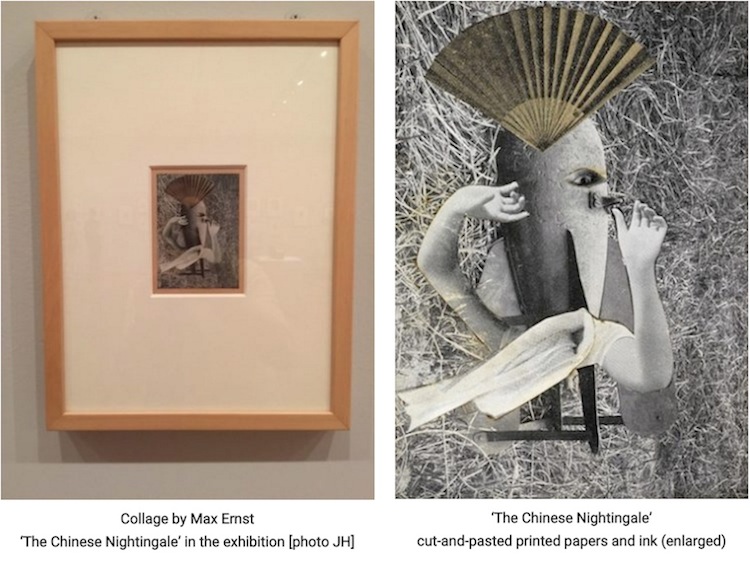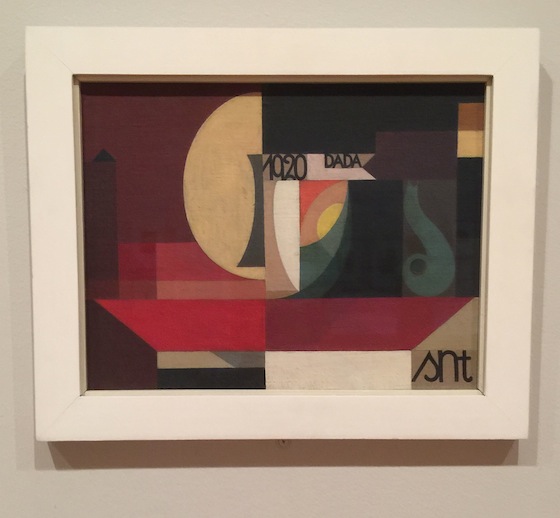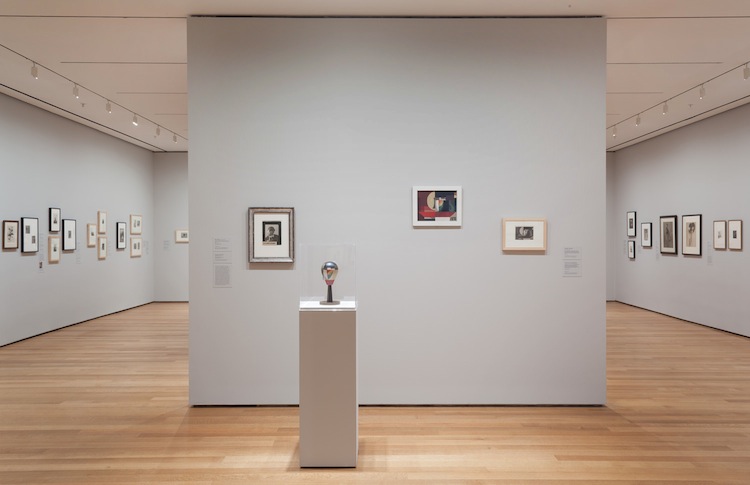Although “Dadaglobe Reconstructed” at MoMA is a magnificent project of deep-dive reclamation, the catalogue that recreates Tristan Tzara’s never-realized Dadaglobe anthology also recreates the limitations of Tzara’s original concept. The catalogue is printed as he would have done it — in black and white. I prefer seeing the works submitted to him in their original form. Francis Picabia’s “Pharmarcie Duchamp$,” for example . . .
Duchamp’s Pharmacy (Pharmarcie Duchamp$) [ink and gouche on paper] by Francis Picabia
Submitted by Picabia by early January 1921
Dada Composition (Flat Head / tête au plat) by Sophie Taeuber
(Fresco from the Zurich Dada Pantheon) [Oil on canvas], 1920
As the curators point out, a number of contributors to the anthology took the limitations into account and sent works to accomodate black-and-white reproduction. Moreover, Tzara liked the idea that Dadaglobewas itself a transformative expression of the works. Nevertheless, give me the originals.
Partial view of the ‘Dadaglobe Reconstructed’ exhibition at MoMA. [Photo: Courtesy Museum of Modern Art]

And here’s another reason: The show puts on view works submitted to Tzara that he chose not to include inDadaglobe, as well as works submitted elsewhere that he did. One prime example is George Grosz’s “Dada Picture,” originally intended for another unrealized anthology, Dadaco (designed by John Heartfield and edited by Tzara’s rival, Richard Huelsenbeck).Due to popular command I’ve uploaded seven more photos of the artworks on exhibit. Click on the titles to have a look:
Due to popular command I’ve uploaded seven more photos of the artworks on exhibit. Click on the titles to have a look:
Philippe Soupault: ‘Dada Lifts Everything’ (‘Dada soulève tout’) [ink on printed paper, c. 1921]
Kurt Schwitters: ‘Lahti’ [cut-and-pasted printed papers on paper, 1920]
Francis Picabia: ‘untitled signature’
Marcel Duchamp ‘Bride (Mariée)’ [oil on canvas, 1912]

![Duchamp's Pharmacy (Pharmarcie Duchamp) [ink and gouche on paper) by Francis Picabia]. Submitted by Picabia (Paris), by early January 1921. [Photo: JH]](http://www.artsjournal.com/herman/wp/wp-content/uploads/2016/07/pharmacie-duchamp-fullcropped-560.jpg)


![Portrait of I.K. Bonset ['I am against everything and everyone']](http://www.artsjournal.com/herman/wp/wp-content/uploads/2016/07/2-composite-BONSET.jpg)
![George Grosz’s “Dada Picture,” intended for Dadaco [cut-and-pasted printed papers] [Photo: JH]](http://www.artsjournal.com/herman/wp/wp-content/uploads/2016/07/grosz-collage-original-enh-450.jpg)
Truly excellent expose of Dada’s time & ours. Adds to what we don’t know. We need.
Comment by Cy Lester on 20 July, 2016 at 12:00 pm